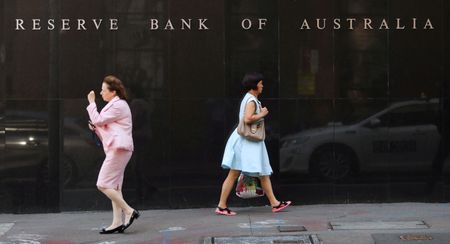By Wayne Cole
SYDNEY (Reuters) -Australia’s central bank on Wednesday said its equity had been wiped out by losses suffered on pandemic-era bond buying, but its ability to create money meant it was not insolvent and would continue as normal.
Reserve Bank of Australia (RBA) Deputy Governor Michele Bullock said the bank had taken a mark-to-market valuation loss on its bond holdings of A$44.9 billion ($30.02 billion) in 2021/22.
The bonds were accumulated under a A$300 billion emergency stimulus programme that ran from November 2020 to February 2022.
The losses eclipsed underlying earnings of A$8.2 billion and left the central bank with an accounting loss of A$36.7 billion. It also ate up all the RBA’s reserve funds, leaving it with a negative net equity position of A$12.4 billion.
Bullock noted that while this would bankrupt a normal commercial entity, the RBA’s liabilities are guaranteed by the government.
“Furthermore, since it has the ability to create money, the Bank can continue to meet its obligations as they become due and so it is not insolvent,” said Bullock.
“The negative equity position will, therefore, not affect the ability of the Reserve Bank to do its job.”
The RBA intends to hold the bonds until maturity and likely make a profit at that time, so offsetting the valuation losses.
Bullock noted other central banks around the world would be facing similar losses on their emergency stimulus programmes, though many did mark their assets to market like the RBA.
In July, the Swiss National Bank reported a first-half loss of 95.2 billion Swiss francs, the biggest since the central bank was founded in 1907.
The RBA also faces ongoing financial losses on its bond holdings which it estimates could range from A$35 billion to as much as A$58 billion out to 2033 when the last of the bonds mature.
As a result, the RBA expects to retain any future profits to rebuild its capital position and thus does not expect to pay any dividend to the government for a number of years, said Bullock.
That also means the RBA would not require a cash injection from the government, as happened in 2013 when the bank suffered valuation losses on its foreign currency reserves.
Treasurer Jim Chalmers earlier said he agreed with the RBA’s position and argued the bond buying programme had played a key part in helping the economy through the pandemic.
Chalmers recently set up an independent inquiry into the RBA’s policy framework, Board structure and communications.
($1 = 1.4954 Australian dollars)
(Reporting by Wayne Cole; Editing by Christian Schmollinger and Sam Holmes)





